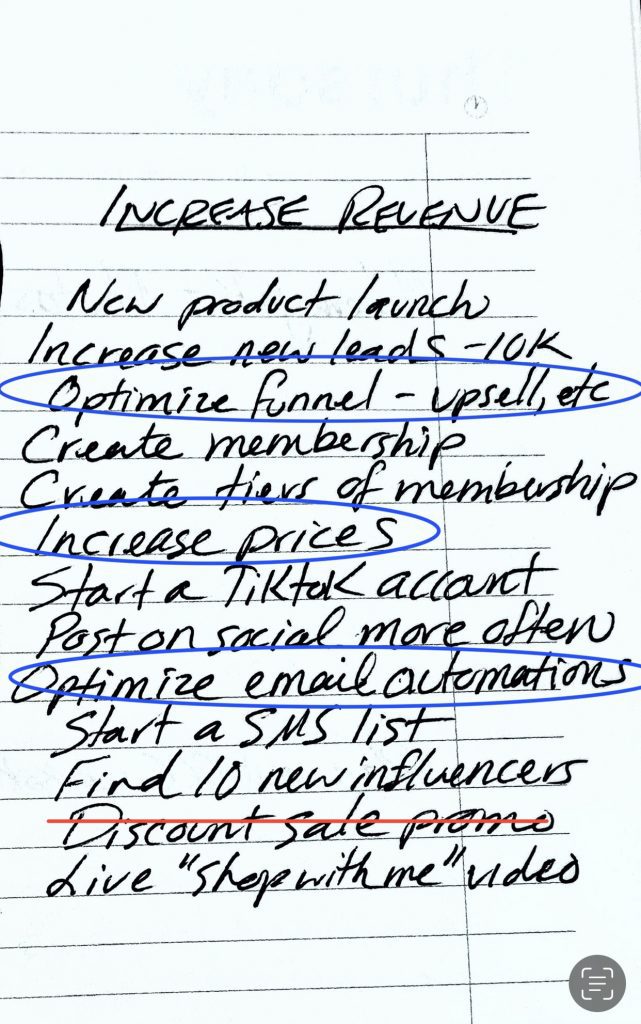Increase Your Revenue!
In Part 1 of how to save your business during a down economy we discussed the method for reducing costs.
Before we move on to revenue, I wanted to show you this little exercise I recommend you do on a regular basis.
Get a big sheet of white paper.
If you have a whiteboard that is even better.
What you’ll do is draw a big line down the middle.
On the left, you’ll write all the ways you can reduce your costs. On the right side, you’ll write all the ways you can increase your revenue.
Think of everything you can. Then you’re going to implement it all, however with the revenue, you need to be careful that it doesn’t send you in multiple directions.
So choose the top three that will have the most impact.
Here’s an example of what it might look like.
I just made this up on the spot just now as an example.

If you were to implement both sides of this note, the net effect would be really huge.
But in this case where we’re focusing on increasing revenue, what we want to do is select the three that would have the most IMMEDIATE impact with the least amount of effort.
There are some ideas here that would work but will require a lot of effort or time to complete and optimize.
What are the lowest hanging fruit here?
Any guesses?
Think through these for a minute.
What could you do right now to improve profit without much work?
Look at them one by one.
Most people start with new channels, making new things, and starting new projects.
That’s a huge mistake when time is of the essence and the margins matter right now.
So, which three would you choose to implement right now?
My answers are below..
⚜️
⚜️
⚜️
⚜️
⚜️

In the first round of “crap, we need to increase our revenue ASAP” I would not start any new projects whatsoever.
Instead, it’s better to OPTIMIZE existing infrastructure: website, funnel, email, etc.
Just think about it like this: (Let’s use easy numbers)…
If your average product is $100 and you have 1000 visitors to your website every month, and you only convert .5% of those visitors into sales, that is 5 customers = $500 in sales.
…But what if you increased the conversion rate of the SAME traffic from .5% to 1%?
Your revenue will immediately DOUBLE without doing anything extra.
No dancing on TikTok, no new product launches, nothing else.
Go further.
What if you increased the conversion rate on your website from 1% to 2%? Now your revenue just jumped to $2,000.
That’s now 4x more revenue without spending more on ads, doing more social media, or doing anything crazy.
Now… imagine using bigger numbers with the same equation.
Now you’re talking taking $5000 to $20,000 just by increasing your conversion rate from .5 to 2%
It’s a big lightbulb moment when you realize this… sometimes the best solutions are not the sexy ones.
But you know what is sexy? Seeing your revenue double or triple 🙂
So… conversion optimization is the short word to summarize a couple of the points on that paper.
Optimizing a funnel includes the entire customer experience from the first second they land on your website, to what happens when they add something to their cart, to what happens after they purchase.
Are there upsells, cross-sells?
Conversion optimization also includes what happens after the purchase in their customer journey, the follow up emails, and so on.
Increase your prices
The other important thing I would prioritize immediately is a price increase on all goods.
Most people under charge due to personal issues with their own perception of money. They feel guilty. They are worried customers will be mad.
We did a price increase a couple times after we started in one business, and even though I knew it was what the business NEEDED (we just weren’t making enough margin), I still struggled with it for months.
Every complaint that came in made me feel bad. I had a couple moments where I wanted to cave.
You know what? I realized that was nothing more than an emotional response. These decisions cannot be emotional. They are MATH DECISIONS.
Math and math alone.
Leave your money issues and beliefs and feelings at the door. They don’t belong on a spreadsheet.
They certainly shouldn’t interfere with logical decisions when can see that your profit margins are too low.
Is there a ceiling to what you can charge?
Yes there is, but that is another blog for another day. Several factors like market sensitivity, brand perception, product quality and more, all play into what you can charge and where that ceiling is. But do not worry about this for now. In 95% of cases, I can guarantee the prices are too low.
Notice I crossed something off the list… I had on there a sale.
This is often the first thing businesses do when they aren’t getting the revenue they need. They hold a sale. Or a promo like BOGO. That might be the worst thing you can do.
Why? Do you know…?
Here are 5 good reasons you shouldn’t run to a sale:
1️⃣ You’re shooting yourself in the foot. You just cut your profit down. The very thing you need.
2️⃣ With a consumable product, if you do a BOGO, now they won’t be back to see you for 2x as long.
3️⃣ Brand perception. Are you a discount brand? If not, be careful to not devalue the brand you’re building.
4️⃣ Customer training. If you do this too often you have just trained your customers to wait to make a purchase until there’s a sale. Now you’re in a pickle.
5️⃣ It’s the easy way out. There’s better, more profitable ways to fix your problem.
So take holding a sale off the plate for this exercise. Of course promos can happen. I especially like a free gift with purchase type of promo, but be careful to not give so much that they don’t feel the need to come back for a while. Anytime you give a free gift, you’re also cutting down your profit (unless it’s a digital gift, which you should absolutely consider!).
So… now it’s your turn.
The list I wrote is absolutely not exhaustive. It’s just a start, but you might be inspired to make a few changes based off this blog.
Are you?
Write me.
What are you going to do with this?
